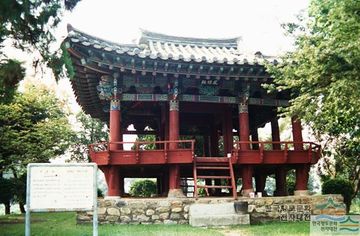김천 봉황대
| 봉황대 |
|
 봉황대, 디지털김천문화대전, 한국학중앙연구원. |
|
| 대표명칭 | 봉황대 |
|---|---|
| 한자 | 鳳凰臺 |
| 주소 | 경상북도 김천시 교동 820-1번지 |
| 지정(등록) 종목 | 경상북도 문화유산자료 |
| 지정(등록)일 | 1985년 8월 5일 |
| 분류 | 유적건조물/주거생활/조경건축/누정 |
| 수량/면적 | 1동 |
| 웹사이트 | 봉황대, 국가유산포털, 국가유산청. |
해설문
국문
봉황대는 연화지, 김산향교 등과 함께 교동이 조선 시대 말까지 김산군(김천의 옛 지명)의 중심 공간이었음을 알려 주는 유적이다. 정면 3칸의 2층 다락 형식으로 지어진 건물이다.
처음에는 조선 숙종 26년(1700)에 김산 관아의 북쪽 구화산 아래에 세워 읍취헌(邑翠軒)으로 부르다가 조선 헌종 4년(1838)에 군수 이능연이 지금 자리인 연화지 중앙으로 옮겼다.
한편 연화지는 숙종 33년(1707)부터 숙종 37년(1711)까지 김산 군수를 지낸 윤택이 솔개가 소란스럽게 노닐다 봉황으로 변해 날아오르는 꿈을 꾼 후 이름을 지었다고 전해진다.
영문
Bonghwangdae Pavilion
This pavilion, located in the middle of Yeonhwaji Reservoir, was used by Confucian scholars of the Joseon period (1392-1910) as a place to recite poetry and discuss Chinese classics. Originally built at the feet of Guhwasan Mountain north of Gimsan (former name of the Gimcheon area) Government Office in 1700, the pavilion was moved to its current location in 1838. The building measures three bays in width and 3 bays depth and is topped by a hip-and-gable roof.
The name Bonghwangdae means "a place where a phoenix plays." This name is said to have been given by Yun Tae-gi*, who served as the local magistrate of Gimsan between 1707 and 1711, after he dreamt of a noisy black kite (Milvus migrans) that turned into phoenix and flew away.
- Or Tae-ki? I'm not sure if we should transcribe ㄱ as "g" in the beginning of the second syllable of the name since there's a hyphen, I just can't remember.
영문 해설 내용
연화지 가운데에 있는 봉황대는 조선시대의 선비들이 시를 읊고 학문을 토론하던 누정이다. 1700년 김산(지금의 김천 지역) 관아의 북쪽 구화산 아래에 세웠다가, 1838년에 지금의 자리로 옮겼다. 정면 3칸, 측면 3칸 규모이며 팔작지붕을 얹었다.
봉황대라는 이름은 “봉황이 노니는 누정”이라는 의미이다. 1707년부터 1711년까지 김산 군수를 지낸 윤택이 솔개가 소란스럽게 노닐다 봉황으로 변해 날아오르는 꿈을 꾼 후 이름을 지었다고 전해진다.